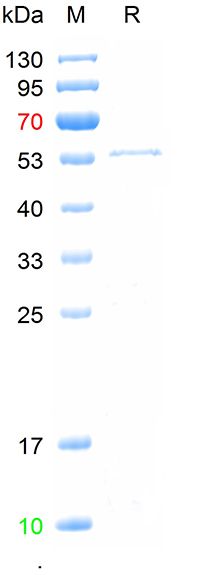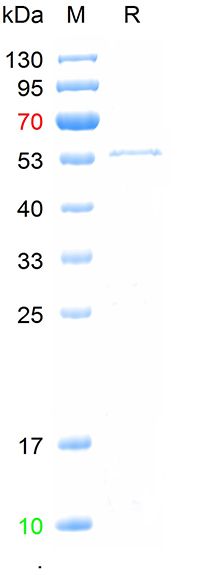重组犬细小病毒VP2蛋白
| 英文名称 | Recombinant CPV VP2 protein, His |
| 中文名称 | 重组犬细小病毒VP2蛋白 |
| 别 名 | Capsid protein VP2; Coat protein VP2; Canine parvovirus; CAPSD_PAVC; Capsid protein VP2 · Canine parvovirus type 2 (CPV-2); Recombinant CPV2 VP2 protein, His |
| 理论分子量 | 42kDa |
| 性 状 | Lyophilized or Liquid |
| 浓 度 | >0.5 mg/ml |
| 物 种 | CPV |
| 序 列 | 201-584/584 |
| 纯 度 | >95% as determined by SDS-PAGE |
| 纯化方法 | AC |
| 内毒素 | Not analyzed |
| 表达系统 | E.coli |
| 活性 | Not tested |
| 标签 | His |
| 缓 冲 液 | 0 mM Tris-HCl (pH=8.0) with 150 mM NaCl. |
| 保存条件 | Stored at -70℃ or -20℃. Avoid repeated freeze/thaw cycles. |
| 注意事项 | This product as supplied is intended for research use only, not for use in human, therapeutic or diagnostic applications. |
| 产品介绍 | Capsid protein self-assembles to form an icosahedral capsid with a T=1 symmetry, about 22 nm in diameter, and consisting of 60 copies of two size variants of the capsid proteins, VP1 and VP2, which differ by the presence of an N-terminal extension in the minor protein VP1. The capsid encapsulates the genomic ssDNA. Capsid proteins are responsible for the attachment to host cell receptor TFRC. This attachment induces virion internalization predominantly through clathrin-endocytosis. Binding to the host receptors also induces capsid rearrangements leading to surface exposure of VP1 N-terminus, specifically its phospholipase A2-like region and nuclear localization signal(s). VP1 N-terminus might serve as a lipolytic enzyme to breach the endosomal membrane during entry into host cell. Intracytoplasmic transport involves microtubules and interaction between capsid proteins and host dynein. Exposure of nuclear localization signal probably allows nuclear import of capsids. |
| 产品图片 |


